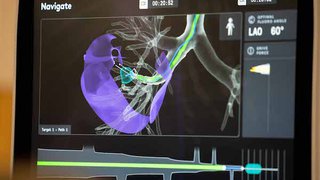How CTEPH treatment can eliminate blood clots in the lungs
March 8, 2019

People who develop a blood clot in the lungs (called an acute pulmonary embolus) typically treat it with blood thinners, which help the body absorb, or remove, the blood clot, usually within three months. However, this treatment method isn’t successful for about 2 percent of these patients who have chronic thromboembolic pulmonary hypertension (CTEPH), a rare form of pulmonary hypertension.
Pulmonary hypertension occurs when blood pressure in the lungs is higher than it should be, affecting the arteries in the lungs and subsequently the right side of the heart. CTEPH causes blood clots to permanently scar the lungs, which leads to the heart squeezing harder in order to pump blood throughout the body. As a result, people can eventually experience heart failure. Common symptoms of CTEPH include:
- Chest pain
- Dizziness
- Fatigue
- Feeling weak
- Shortness of breath, especially during exercise
“The medical community is still making inroads into understanding CTEPH, and as the only place in North Texas that provides treatment for the disease, UT Southwestern is at the forefront of that discovery.”
Sonja Bartolome, M.D.
The medical community is still making inroads into understanding CTEPH, and as the only place in North Texas that provides treatment for the disease, UT Southwestern is at the forefront of that discovery. In 2016, we began offering patients two main treatment options. One patient in her 40s, for example, was a former college athlete and had experienced a decline in her ability to exercise and even do things around the house. We had her undergo tests and determined she had CTEPH. After undergoing surgery, the pressure in her lungs went from abnormally high to healthy, and today she feels great and is running again.
Treatment options for CTEPH
Pulmonary thromboendarterectomy (PTE)
The definitive treatment for CTEPH is surgical PTE, which is performed at UT Southwestern and only a few other medical centers across the country. This procedure involves carefully removing old, scarred-in blood clots from the arteries of the lungs while a heart-lung machine takes over the patient’s circulation.
Once we remove the blood clots, patients can go back to their everyday lives and have a normal lifespan. We often advise patients to take blood thinners for the rest of their lives following surgery to prevent clots from returning.
Balloon pulmonary angioplasty (BPA)
Patients who are not candidates for CTEPH often elect for BPA, a newer endovascular procedure that uses a very thin, flexible tube called a catheter. With advanced imaging technology, we’re able to maneuver the catheter directly to the clots, and the catheter is equipped with a balloon at its tip that’s inserted into the clogged vessel to open it and restore blood flow. BPA is done in stages, often requiring between four to seven different procedures over a few weeks for lung pressure to become healthy again.
UT Southwestern is one of the few places in the U.S. that offer this procedure. Long-term data are not yet available, but we have seen great outcomes with our patients to date. UT Southwestern’s Pulmonary Hypertension Program is also now accredited as a Center of Comprehensive Care through the Pulmonary Hypertension Care Centers (PHCC) program.
How we diagnose CTEPH
Diagnosing CTEPH typically begins with a lung ventilation-perfusion scan, in which we determine where air and blood goes in the lungs. When individuals have CTEPH, air will be going to places where blood isn’t because the blood clot has blocked it off. Then we do an echocardiogram, or an ultrasound, to measure the pressure in the heart and lungs.
If patients show signs of CTEPH, we proceed with more tests, such as:
- Pulmonary angiogram: A test that shows how efficiently blood gets in and out of the lungs. This tells us whether a patient is a candidate for a PTE by determining whether the scarring in the heart and lungs can be reached by a surgeon during surgery.
- Right-heart catheterization: A minimally invasive procedure that uses a catheter to measure the blood pressure in the lungs.
Expert care at UT Southwestern
Specialists in UTSW’s new CTEPH program are trained not only to diagnose and evaluate this often unrecognized condition but also to perform both of the complex procedures to cure it. Our clinic is one of the largest pulmonary hypertension clinics in the U.S., and in it we use a team approach in which cardiologists, radiologists, anesthesiologists, and pulmonologists work together to offer patients true expertise in all aspects of their care.
For patients without more curative options, medication has been shown to improve exercise capacity. The treatment approach is individualized for each patient and focused on achieving the best outcome, including the restoration of quality of life.
To find out whether you or a loved one might benefit from CTEPH treatment, call 214-645-8300 or request an appointment online.











